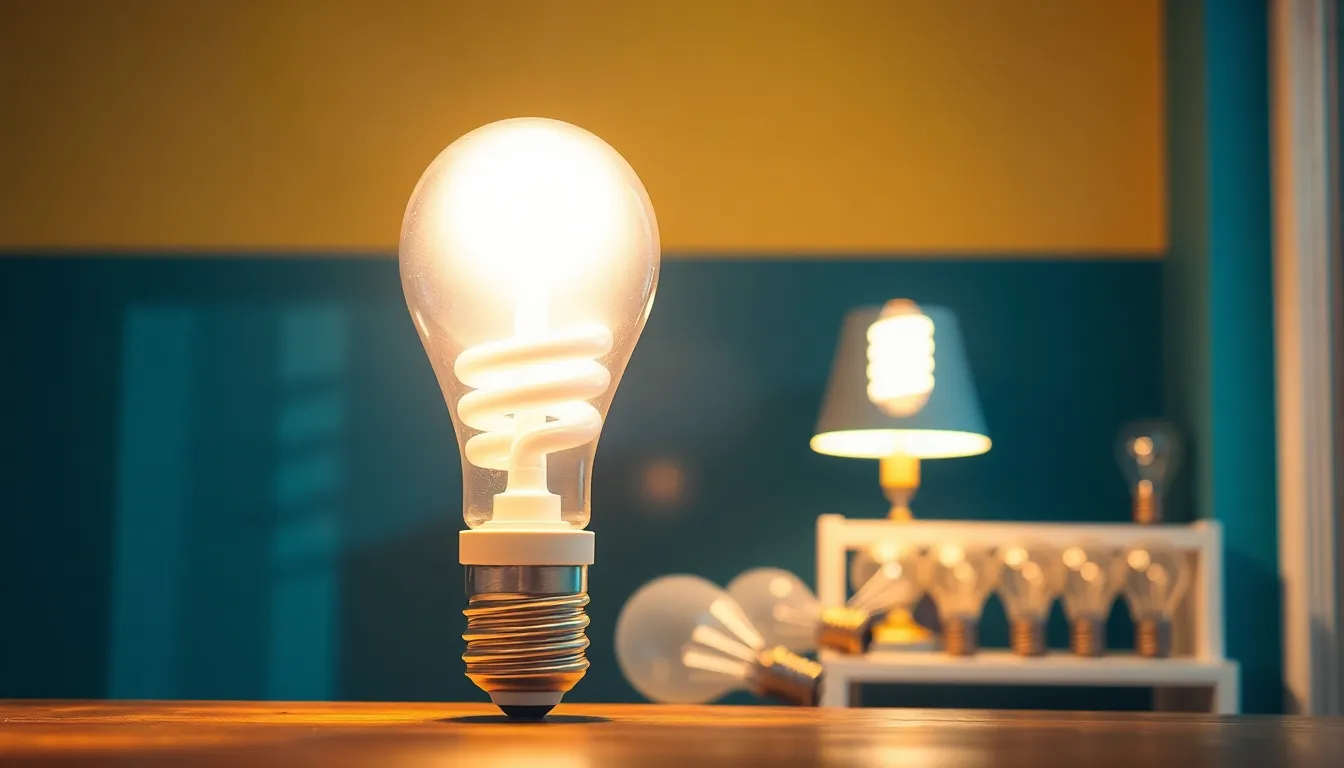Table of Contents
ToggleAs the world becomes increasingly aware of environmental issues, energy-efficient lighting has emerged as a crucial solution for reducing energy consumption. By utilizing advanced technologies, these lighting options not only lower electricity bills but also contribute to a greener planet. The shift from traditional incandescent bulbs to energy-efficient alternatives like LED and CFL lights is transforming the way homes and businesses illuminate their spaces.
With the potential to save significant amounts of energy, energy-efficient lighting is a smart choice for anyone looking to enhance their sustainability efforts. Not only do these options provide long-lasting performance, but they also come with various designs to suit any aesthetic. Embracing energy-efficient lighting is more than just a trend; it’s a step towards a brighter and more sustainable future.
Overview of Energy-Efficient Lighting
Energy-efficient lighting encompasses various technologies designed to use less electricity while providing adequate illumination. Key types include LED (Light Emitting Diode) lights and CFL (Compact Fluorescent Lamp) bulbs. Both options consume significantly less energy than traditional incandescent bulbs, resulting in lower electricity bills.
LED lights boast an efficiency rating of approximately 80% greater than incandescent options. They require minimal energy for the same amount of light output. Additionally, LEDs offer an average lifespan of 15,000 to 25,000 hours, reducing both replacement frequency and environmental waste.
CFL bulbs operate at about 70% less energy than incandescent bulbs and last approximately 7,000 to 10,000 hours. While their initial cost is higher, the energy savings over time often offset the investment.
These lighting options contribute not only to reduced energy consumption but also to decreased greenhouse gas emissions. By switching to energy-efficient lighting, individuals and businesses play a critical role in fostering sustainability and reducing their carbon footprint.
Types of Energy-Efficient Lighting

Energy-efficient lighting includes various technologies that minimize electricity usage while ensuring adequate light levels. Key types encompass LED, CFL, and halogen lighting.
LED Lighting
LED (Light Emitting Diode) lighting stands out for its exceptional efficiency. LEDs consume approximately 80% less energy than traditional incandescent bulbs, with a lifespan ranging from 15,000 to 25,000 hours. This long lifespan significantly reduces the frequency of replacements, leading to lower waste. Additionally, LEDs produce minimal heat compared to incandescent bulbs, enhancing safety and offering a range of color temperatures. The initial investment in LEDs is often offset by substantial savings in energy costs over time.
CFL Lighting
CFL (Compact Fluorescent Lamp) lighting provides another energy-efficient option. CFLs use about 70% less energy than incandescent bulbs and typically last between 7,000 to 10,000 hours. These bulbs generate less heat, improving energy efficiency. While CFLs may have a higher upfront cost, the extended lifespan and reduced energy usage result in considerable savings over their lifetime. It’s common for CFLs to emit a soft light, similar to traditional incandescent options, making them suitable for various lighting needs.
Halogen Lighting
Halogen lighting, a subtype of incandescent bulbs, offers improved efficiency. Halogen bulbs consume less energy than standard incandescent bulbs and have a lifespan of around 2,000 to 4,000 hours. They operate at higher temperatures, providing bright, crisp light. Halogen lights typically have a smaller initial investment compared to LEDs, although their shorter lifespan and higher energy consumption make them less favorable in the long run. Halogen bulbs are often used in applications requiring precise lighting and enhanced color rendering.
Benefits of Energy-Efficient Lighting
Energy-efficient lighting provides numerous advantages, primarily in cost savings, environmental impact, and health benefits. These benefits make energy-efficient lighting an appealing choice for homes and businesses alike.
Cost Savings
Energy-efficient lighting significantly reduces electricity bills. By consuming up to 80% less energy, LED lights result in savings of about $100 per year for an average household. CFLs, operating at 70% less energy, can also deliver substantial savings over their lifespan. Although initial costs may be higher, the long-term savings from reduced energy consumption and lower replacement frequency—LEDs last up to 25,000 hours—make them a more economical option.
Environmental Impact
Energy-efficient lighting considerably lowers carbon footprints. Using these lighting technologies cuts greenhouse gas emissions, with LEDs contributing to a reduction of approximately 683 million metric tons of CO2 annually in the U.S. alone. By decreasing energy consumption, these lighting solutions help reduce reliance on fossil fuels and promote cleaner air. Utilizing energy-efficient lighting aligns with broader sustainability efforts, offering a practical approach to combat climate change.
Health Benefits
Energy-efficient lighting enhances indoor environments by improving light quality. LEDs provide better color rendering, reducing eye strain and increasing productivity. Additionally, they emit less heat, contributing to comfortable indoor temperatures. Some studies suggest that natural-looking light from energy-efficient sources can also positively affect mood and well-being, making these lighting solutions advantageous for both physical and mental health.
Challenges of Implementing Energy-Efficient Lighting
Implementing energy-efficient lighting presents several challenges that can hinder widespread adoption. Key issues include initial costs and public awareness.
Initial Costs
Initial costs often deter consumers and businesses from investing in energy-efficient lighting. LED bulbs, while more cost-effective over time, typically require a higher upfront investment, with prices ranging from $5 to $20 each, compared to incandescent bulbs priced around $1. While long-term savings on energy bills will average about $100 per year for households using LEDs, the immediate expense can create hesitation for many buyers, especially for bulk purchases in commercial applications.
Public Awareness
Public awareness significantly influences the adoption of energy-efficient lighting. Many potential users lack sufficient knowledge about the benefits and savings associated with these technologies. Surveys show that nearly 40% of consumers remain unaware that energy-efficient options, such as LEDs and CFLs, reduce energy consumption by up to 80%. Educational campaigns and clear labeling of products can increase awareness and encourage more people to switch to energy-efficient lighting solutions.
Conclusion
Energy-efficient lighting stands as a vital component in the pursuit of sustainability. By transitioning to technologies like LED and CFL bulbs, individuals and businesses can make a significant impact on energy consumption and environmental health. The long-term savings on electricity bills and the reduction of carbon footprints highlight the practical benefits of these lighting solutions.
While initial costs may pose a challenge, the advantages far outweigh the investment. Increased awareness and education about energy-efficient options are essential for driving wider adoption. Embracing these innovations not only enhances indoor lighting quality but also contributes to a healthier planet. The shift towards energy-efficient lighting is a step towards a brighter and more sustainable future for everyone.







